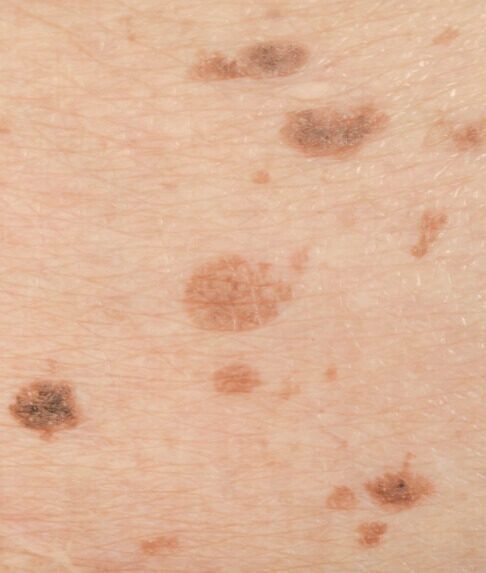
Lentigo: Uncovering the Facts About Liver Spots
Lentigo (plural lentigines) is the formal medical term for what many people informally call “liver spots” because of their dark brown color. Lentigines are a form of hyperpigmentation and, although they are not considered dangerous, many are a form of sun damage-formally called photodamage. The sun emits UV radiation that damages the skin. Although some people claim they are safer than sun exposure, tanning lamps and tanning beds emit UV radiation and cause skin damage, including possibly lentigines. Lentigines appear as small, dark, flat marks with clearly defined borders that stand out against the surrounding skin. Because they are caused by excess sun damage, lentigines tend to appear in individuals age 40 or older. They do not itch or cause any symptoms. In fact, any new dark spots that itch or bleed should be evaluated by a doctor. Interestingly, the most common form of lentigines, lentigo simplex, is not related to sun exposure. This congenital condition is associated with dark markings on the trunk, arms, and legs. Lentigo simplex may be mistaken for freckles, however, freckles tend to be more numerous and can darken with sun exposure, whereas lentigines do not. Lentigo simplex often disappears with time.
How is Lentigo Identified?
Lentigo are benign, meaning that they pose no danger to health. However, they can have an appearance similar to other conditions that are malignant and require treatment. Sometimes a doctor will order a biopsy-a small section of skin is removed and evaluated under a microscope-to rule out disease. Usually, however, a doctor can diagnose a lentigo based on visual assessment alone.
What Causes Lentigines?
Aside from lentigo simplex, most lentigines are caused by ongoing damage to the skin. There are different types of lentigines, named based on the cause and site of occurrence. These include:
1. Solar lentigo: These are lesions caused by sun and ultraviolet radiation exposure. The face, hands, shoulders, chest, and arms are the primary location for these spots, because they have the most exposure. These may be more common and more prominent in fair-skinned individuals.
2. Ink spot lentigo: This relatively rare form of lentigo is characterized by a black color and irregular border.
3. PUVA lentigo: PUVA is a specialized treatment for psoriasis that involves the use of a topical drug called psoralen followed by exposure to UVA radiation (P + UVA). When the development of lentigo is linked to this type of UV exposure, it is called PUVA lentigo.
4. Radiation lentigo: Radiation lentigo occurs in areas of skin that have been exposed to radiation – for example, from cancer treatment. Lentigo may be associated with some other medical conditions, such as:
- Bannayan-Riley-Ruvalcaba syndrome
- Cowden syndrome
- Noonan syndrome
- Peutz-Jeghers syndrome
- Xeroderma pigmentosum
Is Lentigo Dangerous?
Lentigines are not dangerous, and they do not cause any symptoms. However, there are some skin cancers that can have a similar appearance. A doctor can make a diagnosis or order tests, if needed.
Lentigines in Brief
Lentigines-popularly called “liver spots”-are a form of hyperpigmentation and, although they are not considered dangerous, many are a form of sun damage. Lentigines appear as small, dark, flat marks with clearly defined borders that stand out against the surrounding skin.
Did You Know?
The name for lentigines derives from the name of the lentil bean. These small, dark, round marks on the skin are thought to look like lentils.
Lentigines Fast Fact
The average size of lentigines ranges from 0.2 to 2cm, according to the American Osteopathic College of Dermatology.
